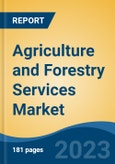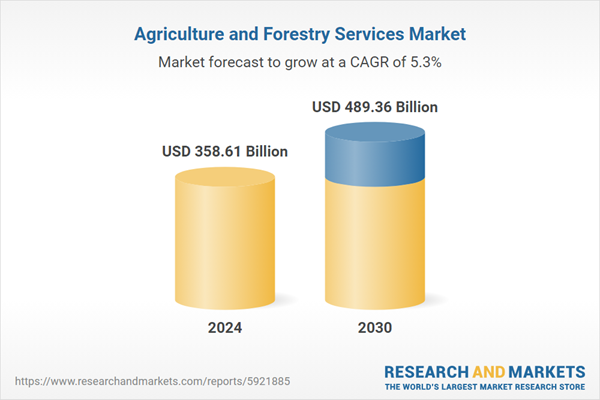Speak directly to the analyst to clarify any post sales queries you may have.
10% Free customizationThis report comes with 10% free customization, enabling you to add data that meets your specific business needs.
Agriculture and Forestry services market encompasses a wide range of activities, including crop cultivation, pest control, precision farming, and forestry management. It serves as a critical support system for farmers, landowners, and forestry enterprises, offering expertise, technology, and solutions to enhance productivity and sustainability. Global agriculture and forestry services market is at the forefront of addressing the complex challenges facing the world's food and timber production. As the industry continues to evolve, a holistic approach that combines technology, sustainability, and collaboration will be key to navigating the path towards a more resilient and productive future. With a focus on innovation and responsible practices, the agriculture and forestry services market is poised to play a crucial role in shaping the sustainable future of global food and resource production.
Key Market Drivers
Global Population Growth
In agriculture, the need for increased food production is steering the adoption of cutting-edge technologies. Precision farming, data-driven decision-making, and the integration of artificial intelligence are becoming indispensable tools to maximize yield and optimize resource utilization. As arable land becomes scarcer, the emphasis on sustainable practices is rising, prompting a surge in demand for services that facilitate eco-friendly farming techniques. Simultaneously, in forestry, the expanding global population is driving an uptick in the demand for wood and paper products. Sustainable forestry management practices are gaining prominence, and forestry services are evolving to balance the extraction of resources with long-term environmental preservation. The forestry sector is witnessing a heightened focus on responsible logging, reforestation initiatives, and ecosystem conservation.According to the United Nations, The world's population is more than three times larger than it was in the mid-twentieth century. The global human population reached 8.0 billion in mid-November 2022 from an estimated 2.5 billion people in 1950, adding 1 billion people since 2010 and 2 billion since 1998. Moreover, Governments and businesses are recognizing the imperative to invest in advanced agricultural and forestry services to ensure food security and sustainable resource management. As the world's population continues its upward trajectory, the agriculture and forestry services market stands at the forefront of innovation and adaptation, poised to meet the challenges and opportunities presented by this demographic surge.
Key Market Challenges
Climate Change Uncertainties
The Agriculture and Forestry Services market, a key player in passive fire protection, is grappling with a significant challenge - escalating raw material costs. The cost dynamics of essential components such as fire-retardant additives and resins are presenting a complex landscape for manufacturers. In this article, we explore the multifaceted repercussions of high raw material costs on the Agriculture and Forestry Services market and the strategies being employed to overcome these challenges. The inherent volatility in the prices of raw materials poses a direct challenge to Agriculture and Forestry Services manufacturers. Fluctuations in the costs of fire-retardant additives and resins directly impact production expenses, creating a scenario where profit margins may be squeezed. The challenge is not merely one of cost, but also the unpredictability that comes with it, making strategic planning and financial forecasting a demanding task.In a market characterized by intense competition, high raw material costs amplify the pressure on manufacturers to remain competitive. Companies must strike a delicate balance between maintaining product quality, adhering to stringent fire safety standards, and managing production costs. Failure to navigate these challenges can result in a loss of market share to competitors who can adapt more effectively to the cost dynamics.
Key Market Trends
Smart Forestry
In the ever-evolving landscape of agriculture and forestry services, the emergence of smart forestry is revolutionizing traditional practices, presenting a paradigm shift that goes beyond mere technological integration. Smart forestry harnesses cutting-edge technologies such as remote sensing, drones, and Geographic Information System (GIS) tools to optimize forest management, ensuring a delicate balance between economic viability and environmental stewardship. One of the key drivers propelling the adoption of smart forestry is the need for efficient resource management. Remote sensing technologies provide real-time insights into forest health, enabling early detection of diseases, pest infestations, and environmental stress factors. Drones equipped with high-resolution cameras navigate dense canopies, offering a bird's-eye view that enhances monitoring precision and aids in timely decision-making.Moreover, GIS tools play a pivotal role in spatially mapping forest ecosystems, facilitating informed planning and sustainable land use. This data-driven approach enables forestry services to identify optimal locations for logging activities, reducing ecological impact and promoting responsible forestry practices. The integration of smart forestry technologies extends beyond environmental considerations; it also addresses economic and operational challenges. Automated timber inventory management systems streamline the tracking and monitoring of wood resources, enhancing supply chain efficiency. Additionally, smart forestry contributes to workforce safety by utilizing automation for hazardous tasks, ensuring a safer working environment for forestry professionals.
Key Market Players
- Cargill Incorporated
- Arbor Forest Management Ltd
- Dairy Farmers of America
- Bayer AG
- West Fraser Timber
- Hancock Victorian Plantations Holdings Pty Limited
- Forestry corporation of NSW
- Rayonier Inc
- China Forestry Group Corporation
- Tilhill Forestry
Report Scope:
In this report, the Global Agriculture and Forestry Services Market has been segmented into the following categories, in addition to the industry trends which have also been detailed below:Agriculture and Forestry Services Market, By Type:
- Timber Production
- Wood Technology
- Forestry Economics
- Others
Agriculture and Forestry Services Market, By Nature:
- Organic
- Conventional
Agriculture and Forestry Services Market, By Application:
- Construction
- Industrial Goods
Agriculture and Forestry Services Market, By Region:
- North America
- United States
- Canada
- Mexico
- Europe
- France
- United Kingdom
- Italy
- Germany
- Spain
- Asia-Pacific
- China
- India
- Japan
- Australia
- South Korea
- South America
- Brazil
- Argentina
- Colombia
- Middle East & Africa
- South Africa
- Saudi Arabia
- UAE
Competitive Landscape
Company Profiles: Detailed analysis of the major companies present in the Global Agriculture and Forestry Services Market.Available Customizations:
With the given market data, the publisher offers customizations according to a company's specific needs. The following customization options are available for the report.Company Information
- Detailed analysis and profiling of additional market players (up to five).
This product will be delivered within 1-3 business days.
Table of Contents
Companies Mentioned
- Cargill Incorporated
- Arbor Forest Management Ltd
- Dairy Farmers of America
- Bayer AG
- West Fraser Timber
- Hancock Victorian Plantations Holdings Pty Limited
- Forestry corporation of NSW
- Rayonier Inc
- China Forestry Group Corporation
- Tilhill Forestry
Table Information
| Report Attribute | Details |
|---|---|
| No. of Pages | 184 |
| Published | February 2025 |
| Forecast Period | 2024 - 2030 |
| Estimated Market Value ( USD | $ 358.61 Billion |
| Forecasted Market Value ( USD | $ 489.36 Billion |
| Compound Annual Growth Rate | 5.3% |
| Regions Covered | Global |
| No. of Companies Mentioned | 10 |









